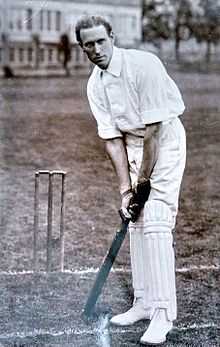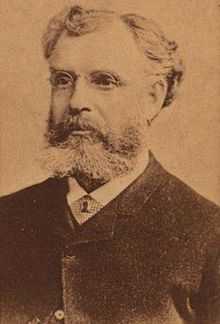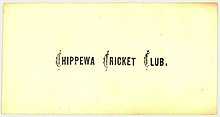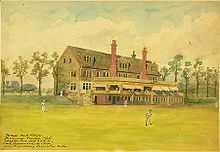History of United States cricket

The history of United States cricket begins in the 18th century. Among early Americans, cricket was as popular a bat and ball game as baseball. Though Americans never played cricket in great numbers, the game grew for some time.[1] Around the time of the United States Civil War, the game began competing with baseball for participants, but then slowly declined in popularity. This was followed again by a brief golden age with the Philadelphian cricket team. This lasted until roughly the start of World War I, at this time cricket again became less popular. In the latter part of the 20th century immigrants from cricket playing nations in south Asia and the West Indies helped spark a resurgence in the game's popularity. This led to participation and success in several International Cricket Council events. In 2007, the United States of America Cricket Association was suspended by the ICC because of problems with its administration, but was again recognized beginning in 2008.
Early developments
Cricket was being played in British North America by at least the beginning of the 18th century.[2] The earliest definite reference to American cricket is in the 1709 diaries of William Byrd of Westover on his James River estates in Virginia.[3] By the American Revolution, the game was so popular that the troops at Valley Forge played matches; George Washington himself joined in at least one game of "wicket."[4] John Adams told Congress that if leaders of simple cricket clubs could be called "presidents," the leader of the new nation might be called something more grand.[5] Cricket continued to develop slowly as a recreational sport as America gained independence in 1783.[6]
History following independence

Cricket enjoyed its greatest popularity along the East Coast corridor between Philadelphia and New York. A contemporary report notes that upwards of 5,000 people played the game in those cities.[7] In 1833, students at Haverford College established what is generally accepted as the first cricket club exclusively for Americans. This club was short-lived, but helped to keep interest in the sport alive in Philadelphia, leading to the foundation of the Philadelphia Cricket Club in 1854[8] and the Germantown and Young America clubs in 1855.[6] By this time, Philadelphia had become the unofficial "Cricket Capital of America."
The United States participated in the first international cricket match, which saw St George's Cricket Club play Canada on September 24, 1844, at the former Bloomingdale Park in Manhattan.[9] The match was attended by some 10,000 spectators, and is today the world's oldest international sporting event.[10][11] Wagers of around $120,000 were placed on the outcome of the match, worth about $1.5 million in 2007.[12]
As late as 1855, the New York press was still devoting more space to coverage of cricket than to baseball.[13]
Sides from England toured the USA and Canada after the English cricket seasons of 1859, 1868 and 1872, in tours organized as commercial ventures. The 1859 team comprised six players from the All-England Eleven and six from the United All-England Eleven and was captained by George Parr. They played five matches, winning them all. There were no first-class fixtures. The match at New York attracted a crowd that was claimed to be 10,000, all that the ground would hold.
The 1868 tourists were led by Edgar Willsher and those of 1872–3 by R.A. Fitzgerald. The latter side included W.G.Grace.
Most of the matches of these early English touring teams were played "against odds", that is to say the home team was permitted to have more than eleven players (usually twenty-two) in order to make a more even contest.[14]
In spite of all this American growth in the game, it was slowly losing ground to a newcomer. In many cities, local cricket clubs were contributing to their own demise by encouraging crossover to the developing game of baseball. After the United States Civil War the Cincinnati Red Stockings brought a talented young bowler from the St. George's Cricket Club in New York to serve as a player and manager of the team. Harry Wright applied the "scientific" batting and specialized placement of fielders that he had learned in cricket to his new sport. This development was instrumental in creating the Cincinnati team's undefeated 1869 season. It also helped to secure the place of baseball as one of the most popular sports in the country.[15]
It may have been during the Civil War that baseball secured its place as America's game.[15] An army making a brief stop at a location could easily organise a game of baseball on almost any clear patch of ground, whilst cricket required a carefully prepared pitch. Baseball began to poach players and administrators from the world of cricket. Nick Young, who served for 25 years as the president of the National League, was originally a successful cricketer. It was not until the Civil War that he took up baseball because "it looked like cricket for which his soul thirsted."[16] It has been suggested that the fast-paced quick play of baseball was more appealing to Americans than the technical slower game of cricket.[15] This natural tendency toward baseball was compounded by terrible American defeats at the hands of a traveling English side in 1859, which may have caused Americans to think that they would never be successful at this English game.[17] By the end of the Civil War, most cricket fans had given up their hopes of broad-based support for the game. Baseball filled the role of the "people's game" and cricket became an amateur game for gentlemen.[15][18]
Rise of amateur cricket
Following the Civil War, cricket grew into an amateur sport with much less broad appeal than it had had before. This manifestation can be seen in the foundation of the Staten Island Cricket and Baseball Club. The club was to be based on "the broadest and most liberal interpretation of the terms 'gentlemen' and amateur." They were not that interested in playing baseball, but in founding a more responsive club in the area than the St George's Cricket Club.[19] The members of the Seabright Lawn Tennis Club became so interested in cricket that they convinced club officials to sod their cricket ground with turf imported from England and had the name of the club changed to the Seabright Lawn Tennis and Cricket Club in 1885.[20]

Nowhere was this new trend in cricket more evident than in Philadelphia. In 1865 a group of young people in that city founded the Merion Cricket Club. They were very emphatic about the purity of the sport and thwarted early attempts by some to convert the club into baseball club.[22] In the end, the club members passed a resolution that the remaining baseball equipment "be sold off as quickly as possible" to guarantee the purpose of the club.[23] Following the lead of New York and Philadelphia, other cities saw new clubs form. These included St Louis, Boston, Detroit, and Baltimore.[24]
These decades also saw an increase in cricket-playing at the intercollegiate level. Following the Civil War, it looked like cricket might expand beyond its strongholds at Haverford College and the University of Pennsylvania. Members of these schools joined together with delegates from other collegiate cricket clubs, including Harvard University, Columbia University, and Princeton University, to form the Intercollegiate Cricket Association in 1881.[25] The group was plagued by troubles and withdrawals. Other schools, such as Cornell University, joined the ICA, but Yale University and Johns Hopkins University never got around to fielding a team. The ICA it lasted until 1924 when it crowned its last champion.[26][27] These collegiate clubs generally drew their talent from pools at secondary schools which also fielded team and played in interscholastic competitions in this period.
Philadelphian cricket

The Philadelphian cricket team was a team that represented Philadelphia in first-class cricket between 1878 and 1913. The team was composed of players from the four chief cricket clubs in Philadelphia: Germantown, Merion, Belmont, and Philadelphia. Players from smaller clubs, such as Tioga and Moorestown, and local colleges, such as Haverford, also played for the Philadelphians. Over its 35 years, the team played in 88 first-class cricket matches. Of those, 29 were won, 45 were lost, 13 were drawn and one game was abandoned before completion.[28] The "Gentlemen of Philadelphia" were able to win at least a match or two from all of the foreign sides that visited. They beat Australia's test team by an innings on two separate occasions, in 1893 and 1896[29] Throughout their first-class period of play, the Philadelphians produced such cricketers as Bart King, George Patterson, and John Lester.
The success of the team and of the sport itself in Philadelphia was the result of broad support from the citizens of the city.[29] Crowds of several thousand fans "ranging from millionaires, coaching parties, and box holders to newsboys" routinely filled the stands at the big four clubs during international matches.[30] These matches were also widely reported in local newspapers. Unlike the other regional pockets of cricket enthusiasm across the country, the sport maintained is popularity for almost two decades into the twentieth century.[29]
In 1897, the Gentlemen of Philadelphia were able to launch its first strictly first-class tour of England. This came about after many years of planning.This tour was a very ambitious one for the Americans. They had last toured the British Isles in 1889. Though the results may have been less satisfactory than hoped for by promoters, the tour was arranged mainly for educational purposes and few of those on the American side expected to win many matches.[31] The 1897 schedule included all of the top county cricket teams, the Oxford and Cambridge University teams, the Marylebone Cricket Club, and two other sides, though only a few of the counties thought it worthwhile to put their best elevens onto the field.[31] While it initially aroused some curiosity, many English fans lost interest until Bart King and the Philadelphians met the full Sussex team at Brighton on 17 June. In the first innings, King proved his batting worth on a fourth-wicket stand of 107 runs with John Lester.[32] He then took 7 wickets for 13 runs and the team dismissed Sussex for 46 in less than an hour.[33] In the second innings, King took 6 for 102 and helped the Philadelphians to a victory by 8 wickets.[34]
The Philadelphians again took King and his teammates to England in 1903. On this tour, the team rarely found itself outmatched. By the end of the tour, some English observers were comparing the Philadelphian team to some of the Australian sides that they had seen.[35] One of the highlights of the tour was the win over Gloucestershire by an innings and 26 runs. This was the worst defeat ever by an American side over an English county side.[36] The Americans back home believed that this was the country's chance to burst onto the world cricket stage.[37] Unfortunately, this was followed by a relatively poor showing in 1908. The only bright spot of this tour was Bart King's capture of the season bowling record. His record of 11.01 was not bettered until 1958 when Les Jackson of Derbyshire posted an average of 10.99.[38]
Decline of popularity

Even as the Philadelphians were faring poorly in England in 1908, a more disturbing trend was showing itself back home in Philadelphia. The sport's grassroots popularity was waning. Many Philadelphian professionals began to fill their leisure time with other activities such as golf and tennis. Starting around 1905, the number of matches held in the city dropped off. Some of the great clubs of the city even began to close down due to lack of members. Bart King's own Belmont Cricket Club sold its grounds and disbanded in 1914. The sport slowly declined in Philadelphia and the last first-class match in the city was played in 1913.[39] The game was still being played at Haverford College at least as late as 1925, when a team from the college visited England and played a number of English public schools.[40]
Another blow to cricket in the United States was the formation of the Imperial Cricket Conference in 1909. As the name implied, this was meant to be an organization for cricketing nations in the British Empire. Countries such as Australia and South Africa were able to continue playing internationally, while the United States was left out. Although commentator Robert Waller predicted that cricket "had taken so deep a root in Philadelphia that it could never be uprooted,"[41] the lack of support and international apathy caused an irreversible decline.[42]
Slow resurgence
In the second half of the twentieth century, immigrants to the United States from traditional cricket strongholds such as South Asia and the West Indies helped to stimulate the growth of the game. The first match televised in the United States was one between the Corinthians and Hollywood in 1958.[43] Cricket received a boost in the United States in 1959 when President Dwight D. Eisenhower attended a cricket match at Karachi's National Cricket Ground.[44] In 1961, an expatriate Englishman, John Marder, helped to establish the United States of America Cricket Association.[42] He also helped to re-establish the series between the United States and Canada that began in 1844.[45] Cricket also gained ground in American collegiate settings during this period. Again, most of the play was done by foreign students visiting the United States to study.[43] This slow but steady resurgence in the game has not spread in great numbers to the mainstream American population.[42]
Modern developments
The United States of American Cricket Association was admitted as an associate member of the International Cricket Conference in 1965. This was the same group that had been so integral in keeping the United States out of international cricket when formed in 1909.[42] The United States was also able to participate in the ICC Trophy when the tournament started in 1979. They have been successful and have continued to improve.[43] Unfortunately, the administration of the USACA has proved unable to administer the sport in the United States effectively. This has led to suspensions from tournaments and ineligibilities. In May 2007 the USA were to visit Darwin, Australia to take part in Division Three of the ICC World Cricket League.[46] A top two finish in this tournament would have qualified them for Division Two of the same tournament later in the year.[46] Unfortunately, the USACA was suspended from the ICC and the team was pulled from this competition.[47]
Compton Cricket Club
The Compton Cricket Club, or CCC, is a cricket club based in Compton, Los Angeles County, California, USA. The CCC is an all American-born disadvantaged exhibition cricket team. The team, which includes Latino and African American ex-gang members, was founded in 1995 by US homeless activist Ted Hayes and Hollywood movie Producer Katy Haber to combat the negative effect of poverty, urban decay and crime in Compton. The club uses the ideals of sportsmanship, and the particular importance of etiquette and fair play in cricket, to help players develop respect for authority, a sense of self-esteem and self-discipline. Having toured England once as a homeless team and 3 times as the Compton Cricket Club, the club toured Australia in 2011 and became the first American born cricket club to tour to Australia.[48][49]
Pro Cricket
In 2004 a professional cricket league called Pro Cricket was formed with eight geographically distributed teams organized in two divisions. Most teams used minor league baseball parks as home fields during that first and only year of league operation. However, with the absence of adequate revenue the league closed at the end of the 2004 season.
Major League Cricket
United States Youth Cricket Association
American-born Test cricketers
Although the United States is only an associate member of the ICC and has never played a Test match, two Test cricketers have been born in the USA. Ken Weekes was born in Boston, Massachusetts, in 1912 and played in two of the Tests on the West Indies' tour of England in 1939. Weekes scored 137 at The Oval in the last Test match before the Second World War. Weekes eventually returned to the United States from Jamaica, and died in Brooklyn in 1998.[50]
Later, the Washington-born Jehan Mubarak became an international Test player. He has played 8 Tests and 20 One Day Internationals for Sri Lanka.[51]
See also
Notes
- ↑ Melville, Tom. Cricket for Americans: Playing and Understanding the Game. (Bowling Green, Ohio: Bowling Green States University Popular Press, 1993), 73.
- ↑ Worrall, Simon (n.d.). "Cricket, Anyone?". Smithsonian Institution Magazine. Retrieved 2007-03-30.
- ↑ Byrd, William. The Secret Diary of William Byrd of Westover. (Richmond, Virginia: Dietz Publishing, 1941), 144, 146.
- ↑ Ewing, George. The Military Journal of George Ewing. (New York: Privately Printed, 1928), 47.
- ↑ McCullough, David. John Adams. (New York: Simon & Schuster, 2001), 405.
- ↑ 6.0 6.1 Melville, Tom. Cricket for Americans: Playing and Understanding the Game. (Bowling Green, Ohio: Bowling Green States University Popular Press, 1993), 74.
- ↑ Kirsch, George. "American Cricket: Players and Clubs Before the Civil War." Journal of Sports History (Spring 1984), 29.
- ↑ Murdoch, Joseph (n.d.). "Philadelphia Cricket Club View Library Document: History". Philadelphia Cricket Club. Archived from the original on 28 September 2007. Retrieved 2007-03-30.
- ↑ Das, Deb (n.d.). "Cricinfo – Cricket in the USA". Cricinfo. Retrieved 2007-03-09.
- ↑ "Canada Versus United States of America Cricket 1844 St George Cricket Club Ground, Manhattan, New York". Cricket Club. n.d. Archived from the original on 3 February 2007. Retrieved 2007-03-09.
- ↑ In a bit of turnabout, the UK won the first Baseball World Cup Tournament, defeating the United States in an American game developed from the British game of Rounders.
- ↑ "Canada Cricket Online". Canada Cricket. n.d. Retrieved 2007-03-09.
- ↑ Markovits, Andrei S.; Steven L. Hellerman (2001). Offside: soccer and American exceptionalism. Princeton University Press. p. 56. ISBN 0-691-07447-X.
- ↑ Alan Gibson, The Cricket Captains of England, The Pavilion Library, 1989, ISBN 1-85145-390-3, 4–7.
- ↑ 15.0 15.1 15.2 15.3 Melville, Tom. Cricket for Americans: Playing and Understanding the Game. (Bowling Green, Ohio: Bowling Green States University Popular Press, 1993), 75.
- ↑ Irwin, Will. "Baseball Before the Professionals Came." Collier's Weekly. (8 May 1909), 12–13.
- ↑ Frank Leslie's Illustrated Weekly (5 October 1859).
- ↑ Adelman, Melvin. A Sporting Time: New York City and the Rise of Modern Athletics, 1820–1870. (Urbana, Illinois: University of Illinois Press, 1986).
- ↑ Clay, Charles. "The Staten Island Cricket and Baseball Club." Outing. (November 1887), 101–112.
- ↑ Prentice, Bernon. History of the Seabright Lawn Tennis and Cricket Club. (New Jersey: Privately Printed, 1937).
- ↑ Walter Leighton Clark
- ↑ Melville, Tom. Cricket for Americans: Playing and Understanding the Game. (Bowling Green, Ohio: Bowling Green States University Popular Press, 1993), 76.
- ↑ The Merion Cricket Club, 1865–1965. (Philadelphia: Merion Cricket Club, 1965).
- ↑ Melville, Tom. Cricket for Americans: Playing and Understanding the Game. (Bowling Green, Ohio: Bowling Green States University Popular Press, 1993), 76–77.
- ↑ The New York Times (27 April 1881), 8.
- ↑ Melville, Tom. Cricket for Americans: Playing and Understanding the Game. (Bowling Green, Ohio: Bowling Green States University Popular Press, 1993), 77–78.
- ↑ Presbrey, Frank. Athletics at Princeton: A History. (New York: Presbrey Company, 1901), 20–30, 557–561.
- ↑ A summary of the team's first-class matches can be found here.
- ↑ 29.0 29.1 29.2 Melville, Tom. Cricket for Americans: Playing and Understanding the Game. (Bowling Green, Ohio: Bowling Green States University Popular Press, 1993), 80.
- ↑ Pleasants, Henry. From Kitts to Pantaloons. (West Chester, Pennsylvania: Temple University, 1945), 145.
- ↑ 31.0 31.1 "Wisden – 1898 – The Philadelphians in England, 1897". John Wisden & Co. 1898. Retrieved 2007-01-31.
- ↑ "Sussex v Philadelphians in 1897". CricketArchive. 2003–2007. Retrieved 2007-02-09.
- ↑ Barker, Ralph (1967). Ten Great Bowlers. Chatto and Windus. pp. 124–155.
- ↑ "Obituary of John Barton King", Cricket Quarterly 31 (1), 1966: 61
- ↑ Melville, Tom. Cricket for Americans: Playing and Understanding the Game. (Bowling Green, Ohio: Bowling Green States University Popular Press, 1993), 82.
- ↑ Melville, Tom. Cricket for Americans: Playing and Understanding the Game. (Bowling Green, Ohio: Bowling Green States University Popular Press, 1993), 96.
- ↑ The New York Times. (16 August 1903), 12.
- ↑ Synge, Allen (2007). "SABR UK Examiner no.10: Baseball and Cricket: Cross-Currents". Society for American Baseball Research (UK Chapter). Retrieved 2007-01-31.
- ↑ Melville, Tom. Cricket for Americans: Playing and Understanding the Game. (Bowling Green, Ohio: Bowling Green States University Popular Press, 1993), 83.
- ↑ Haverford College in England, 1925 Retrieved 1 November 2010.
- ↑ Wister, William. Some Reminiscences of Cricket in Philadelphia Before 1861. (Philadelphia, Allen Publishing, 1904), 142.
- ↑ 42.0 42.1 42.2 42.3 Melville, Tom. Cricket for Americans: Playing and Understanding the Game. (Bowling Green, Ohio: Bowling Green States University Popular Press, 1993), 84.
- ↑ 43.0 43.1 43.2 Marder, John; Adrian Cole (2007). "Cricinfo – Cricket in the USA". Cricinfo. Retrieved 2007-01-31.
- ↑ Melville, Tom. Cricket for Americans: Playing and Understanding the Game. (Bowling Green, Ohio: Bowling Green States University Popular Press, 1993), 108.
- ↑ Marder, John. The International Series: The Story of the United States vs. Canada at Cricket. (London: Kaye and Ward, 1968) is cited in Tom Melville's Cricket for Americans: Playing and Understanding the Game. (Bowling Green, Ohio: Bowling Green States University Popular Press, 1993), 85.
- ↑ 46.0 46.1 World Cricket League Structure Accessed 4 April 2007.
- ↑ ICC Board Suspends USACA, ICC official site Accessed 4 April 2007.
- ↑ http://www.comptoncricketclub.org/ Accessed 4 April 2007.
- ↑ http://video.news.sky.com/skynews/video/?&videoSourceID=1298899&flashURL=/feeds/skynews/latest/flash/archive02/nisbet_cricket.flv/ Accessed 4 April 2007.
- ↑ Cricinfo profile:Ken Weekes
- ↑ Cricinfo profile:Jehan Mubarak